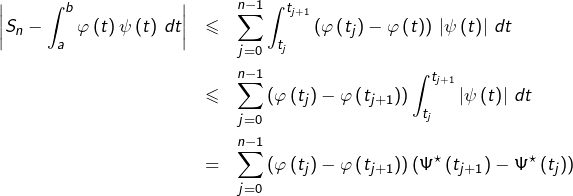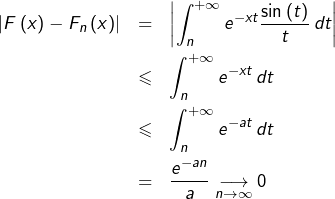
Il existe deux formules de moyenne pour les intégrales.
Elles sont attribuées au mathématicien Pierre-Ossian Bonnet (1819 – 1892).
On se propose de les énoncer, de les établir et d’en donner des exemples significatifs d’utilisation.
Des versions plus fortes de ces résultats existent dans la littérature, mais on a choisi ici de privilégier la simplicité à la généralité.

Première formule de la moyenne
On suppose que ![]() et
et ![]() sont des applications continues d’un segment
sont des applications continues d’un segment ![]() dans
dans ![]()
Proposition 1
Si ![]() est positive, alors il existe
est positive, alors il existe ![]() tel que :
tel que :
![]()
Notons respectivement ![]() et
et ![]() le minimum et le maximum de
le minimum et le maximum de ![]() Pour tout
Pour tout ![]() :
:
![]()
![]()
![]()
![Rendered by QuickLaTeX.com \[m\leqslant\dfrac{\int_{a}^{b}\varphi\left(t\right)\psi\left(t\right)\thinspace dt}{\int_{a}^{b}\psi\left(t\right)\thinspace dt}\leqslant M\]](https://math-os.com/wp-content/ql-cache/quicklatex.com-0a88ec2cc3869a62a0772ac5cef718ef_l3.png)
![Rendered by QuickLaTeX.com \[\dfrac{\int_{a}^{b}\varphi\left(t\right)\psi\left(t\right)\thinspace dt}{\int_{a}^{b}\psi\left(t\right)\thinspace dt}=\varphi\left(c\right)\]](https://math-os.com/wp-content/ql-cache/quicklatex.com-fafee4926e231e20e3581e9bf82df908_l3.png)
Remarque 1
On peut remplacer l’hypothèse ![]() positive par
positive par ![]() de signe constant. Si
de signe constant. Si ![]() est à valeurs négatives, il suffit en effet d’appliquer ce qui précède au couple
est à valeurs négatives, il suffit en effet d’appliquer ce qui précède au couple ![]()
En outre, la continuité de ![]() n’a pas servi : on peut se contenter de supposer que
n’a pas servi : on peut se contenter de supposer que ![]() est continue par morceaux, ou même seulement Riemann-intégrable.
est continue par morceaux, ou même seulement Riemann-intégrable.
Remarque 2
En choisissant pour ![]() la fonction constante égale à 1, on obtient pour toute application continue
la fonction constante égale à 1, on obtient pour toute application continue ![]() , l’existence d’un réel
, l’existence d’un réel ![]() tel que :
tel que :
![]()
Seconde formule de la moyenne
On suppose toujours que ![]() et
et ![]() sont des applications d’un segment
sont des applications d’un segment ![]() dans
dans ![]()
Proposition 2
Si ![]() est décroissante et positive et si
est décroissante et positive et si ![]() est continue par morceaux (ou seulement Riemann-intégrable), alors il existe
est continue par morceaux (ou seulement Riemann-intégrable), alors il existe ![]() tel que :
tel que :
![]()
Preuve simplifiée n° 1
➡ Supposons en outre ![]()
L’application :
![]()
![]()
![]()
Remarque
Sans hypothèse de positivité pour ![]() on peut considérer plutôt :
on peut considérer plutôt :
![]()
![]()
![Rendered by QuickLaTeX.com \[\fcolorbox{black}{myBlue}{$\displaystyle{\int_{a}^{b}\varphi\left(t\right)\psi\left(t\right)\thinspace dt=\varphi\left(a\right)\int_{a}^{c}\psi\left(t\right)\thinspace dt+\varphi\left(b\right)\int_{c}^{b}\psi\left(t\right)\thinspace dt}$}\]](https://math-os.com/wp-content/ql-cache/quicklatex.com-1b07c86d2bca5828bfca45670ede448c_l3.png)
Preuve simplifiée n° 2
➡ Supposons en outre ![]() de classe
de classe ![]() et
et ![]() continue.
continue.
Posons ![]() Comme
Comme ![]() est continue,
est continue, ![]() est de classe
est de classe ![]() et
et ![]() Après intégration par parties :
Après intégration par parties :
![]()
![]()
![]()
Sinon :
![]()
![]()
Preuve simplifiée n° 3
➡ Supposons en outre ![]() continue.
continue.
Etant donné ![]() notons pour tout
notons pour tout ![]() :
:
![]()
![Rendered by QuickLaTeX.com \[S_{n}=\sum_{j=0}^{n-1}\int_{t_{j}}^{t_{j+1}}\thinspace\varphi\left(t_{j}\right)\psi\left(t\right)\thinspace dt\]](https://math-os.com/wp-content/ql-cache/quicklatex.com-364b1e43c5def751879d4168a328f19b_l3.png)
(![]() )
) ![Rendered by QuickLaTeX.com \[\fcolorbox{black}{myBlue}{$\displaystyle{\lim_{n\rightarrow+\infty}S_{n}=\int_{a}^{b}\varphi\left(t\right)\psi\left(t\right)\thinspace dt}$}\]](https://math-os.com/wp-content/ql-cache/quicklatex.com-3d630fb749ebfba4a0d0f657a7e43cdd_l3.png)
Pour tout ![]() :
:
![Rendered by QuickLaTeX.com \[S_{n}-\int_{a}^{b}\varphi\left(t\right)\psi\left(t\right)\thinspace dt=\sum_{j=0}^{n-1}\int_{t_{j}}^{t_{j+1}}\left(\varphi\left(t_{j}\right)-\varphi\left(t\right)\right)\thinspace\psi\left(t\right)\thinspace dt\]](https://math-os.com/wp-content/ql-cache/quicklatex.com-96f8d1b62b0486efee1f2a1a0875e73d_l3.png)
![Rendered by QuickLaTeX.com \[\left|S_{n}-\int_{a}^{b}\varphi\left(t\right)\psi\left(t\right)\thinspace dt\right|\leqslant\sum_{j=0}^{n-1}\int_{t_{j}}^{t_{j+1}}\left|\varphi\left(t_{j}\right)-\varphi\left(t\right)\right|\thinspace\left|\psi\left(t\right)\right|\thinspace dt\]](https://math-os.com/wp-content/ql-cache/quicklatex.com-daaae9c9f8117a2d4beb7bf26ed7fb04_l3.png)
![]()
![]()
![]()
Par ailleurs, en notant
![]()

![]()
![]()
![]()
![]()
![Rendered by QuickLaTeX.com \[m\leqslant\dfrac{\int_{a}^{b}\varphi\left(t\right)\thinspace\psi\left(t\right)\thinspace dt}{\varphi\left(a\right)}\leqslant M\]](https://math-os.com/wp-content/ql-cache/quicklatex.com-08c0705e750db3ade7c9953fefc94c41_l3.png)
![Rendered by QuickLaTeX.com \[\dfrac{\int_{a}^{b}\varphi\left(t\right)\thinspace\psi\left(t\right)\thinspace dt}{\varphi\left(a\right)}=\Psi\left(c\right)\]](https://math-os.com/wp-content/ql-cache/quicklatex.com-c5544a2f8a66da0a37e3072db20710f4_l3.png)
Preuve du cas général
Rappel : on suppose ![]() décroissante positive et
décroissante positive et ![]() continue par morceaux (ou seulement Riemann-intégrable).
continue par morceaux (ou seulement Riemann-intégrable).
Nous allons constater que la relation ![]() de la preuve simplifiée n° 3 reste vraie. En gros, on perd l’uniforme continuité de
de la preuve simplifiée n° 3 reste vraie. En gros, on perd l’uniforme continuité de ![]() mais on a toujours celle de
mais on a toujours celle de
![]()

![]()
![]()
Deux exemples d’utilisation
➡ Exemple 1
Soit ![]() On considère une application continue
On considère une application continue ![]() , une application
, une application ![]() continue et
continue et ![]() périodique et l’on s’intéresse au calcul de :
périodique et l’on s’intéresse au calcul de :
![]()
Pour tout ![]() posons :
posons :
![]()
![]()
![Rendered by QuickLaTeX.com \[J_{n}=\dfrac{1}{n}\sum_{k=0}^{n-1}\int_{kT}^{\left(k+1\right)T}f\left(\dfrac{x}{n}\right)g\left(x\right)\thinspace dx\]](https://math-os.com/wp-content/ql-cache/quicklatex.com-3b82474eb3c199c9e6e3b81924d7a3cc_l3.png)
![Rendered by QuickLaTeX.com \[J_{n}=\dfrac{1}{n}\sum_{k=0}^{n-1}\int_{0}^{T}f\left(\dfrac{s+kT}{n}\right)g\left(s+kT\right)\thinspace ds\]](https://math-os.com/wp-content/ql-cache/quicklatex.com-498cbd2e4be70c673e29f034321a00b8_l3.png)
![Rendered by QuickLaTeX.com \[J_{n}=\dfrac{1}{n}\sum_{k=0}^{n-1}\int_{0}^{T}f\left(\dfrac{s+kT}{n}\right)g\left(s\right)\thinspace ds\]](https://math-os.com/wp-content/ql-cache/quicklatex.com-96b2f62e2f93c1e1e16fcf2a20dc7fd6_l3.png)
![]()
![Rendered by QuickLaTeX.com \[J_{n}=S_{n}\thinspace\int_{0}^{T}g\left(s\right)\thinspace ds\qquad\text{avec : }R_{n}=\dfrac{1}{n}\sum_{k=0}^{n-1}f\left(\dfrac{c_{k}+kT}{n}\right)\]](https://math-os.com/wp-content/ql-cache/quicklatex.com-a4851dfa6b503f92b854dd1c4ede23cb_l3.png)
![]()

![Rendered by QuickLaTeX.com \[\boxed{\lim_{n\rightarrow+\infty}\int_{0}^{T}f\left(t\right)g\left(nt\right)\thinspace dt=\left(\int_{0}^{T}f\left(s\right)\thinspace ds\right)\left(\dfrac{1}{T}\int_{0}^{T}g\left(s\right)\thinspace ds\right)}\]](https://math-os.com/wp-content/ql-cache/quicklatex.com-41c1548322bae78c5cfdd042b26010ab_l3.png)
Remarque
Le lecteur pourra démontrer en exercice une formule un peu plus générale, à savoir que si ![]() est définie sur
est définie sur ![]() (au lieu de
(au lieu de ![]() on obtient en fin de compte :
on obtient en fin de compte :
![Rendered by QuickLaTeX.com \[\fcolorbox{black}{myBlue}{$\displaystyle{\lim_{n\rightarrow+\infty}\int_{a}^{b}f\left(t\right)g\left(nt\right)\thinspace dt=\left(\int_{a}^{b}f\left(s\right)\thinspace ds\right)\left(\dfrac{1}{T}\int_{0}^{T}g\left(s\right)\thinspace ds\right)}$}\]](https://math-os.com/wp-content/ql-cache/quicklatex.com-5dc432c092c72d269c1033f6713db2e7_l3.png)
A titre d’exemple :
![]()
![]()
➡ Exemple 2
Soit ![]() continue telle que l’intégrale
continue telle que l’intégrale ![]() soit semi-convergente. Pour tout
soit semi-convergente. Pour tout ![]() posons :
posons :
![]()
![]() est bien défini par hypothèse. Et pour
est bien défini par hypothèse. Et pour ![]() l’intégrale
l’intégrale ![]() existe d’après le critère de Cauchy. En effet, étant donné
existe d’après le critère de Cauchy. En effet, étant donné ![]() il existe
il existe ![]() tel que pour tout
tel que pour tout ![]() :
:
![]()
![]()
![]()
![]()
![]()
![]()
Un cas particulier célèbre est celui où :
![Rendered by QuickLaTeX.com \[f:\left[0,+\infty\right[\rightarrow\mathbb{R},\thinspace t\mapsto\left\{ \begin{array}{cc}\dfrac{\sin\left(t\right)}{t} & \text{si }t>0\\\\1 & \text{si }t=0\end{array}\right.\]](https://math-os.com/wp-content/ql-cache/quicklatex.com-01814a49208ca20bf44ba4b7dda4aeda_l3.png)
![]()

![]()
![]()
![]()
![Rendered by QuickLaTeX.com \[\boxed{\int_{0}^{+\infty}\dfrac{\sin\left(t\right)}{t}\thinspace dt=\dfrac{\pi}{2}}\]](https://math-os.com/wp-content/ql-cache/quicklatex.com-9b2860d6f89d7356578c75f7d8591e4d_l3.png)
Remarque 1
Dans ce calcul, il était essentiel de prouver la continuité de ![]() en
en ![]() On aurait pu établir la continuité de
On aurait pu établir la continuité de ![]() sur
sur ![]() à moindre frais, car il suffit de prouver la convergence uniforme de la suite
à moindre frais, car il suffit de prouver la convergence uniforme de la suite ![]() sur
sur ![]() pour tout
pour tout ![]() ce qui s’obtient par une majoration directe. En effet, pour tout
ce qui s’obtient par une majoration directe. En effet, pour tout ![]() et tout
et tout ![]() :
:

Remarque 2
Si, dans l’énoncé de l’exemple 2, l’hypothèse de semi-convergence de l’intégrale impropre ![]() est remplacée par l’hypothèse plus forte d’absolue convergence, la continuité de
est remplacée par l’hypothèse plus forte d’absolue convergence, la continuité de ![]() est beaucoup plus simple à établir. En effet, pour tout
est beaucoup plus simple à établir. En effet, pour tout ![]() et pour tout
et pour tout ![]() :
:

Pour toutes questions ou remarques, merci d’utiliser le formulaire de contact.

Sublime ! Une analyse prodigieuse; j’ai appris des techniques pertinentes.
L’exemple 1 est une question classique mais qui est super traitée .
Super et continuez !
C’est un plaisir de lire vos articles